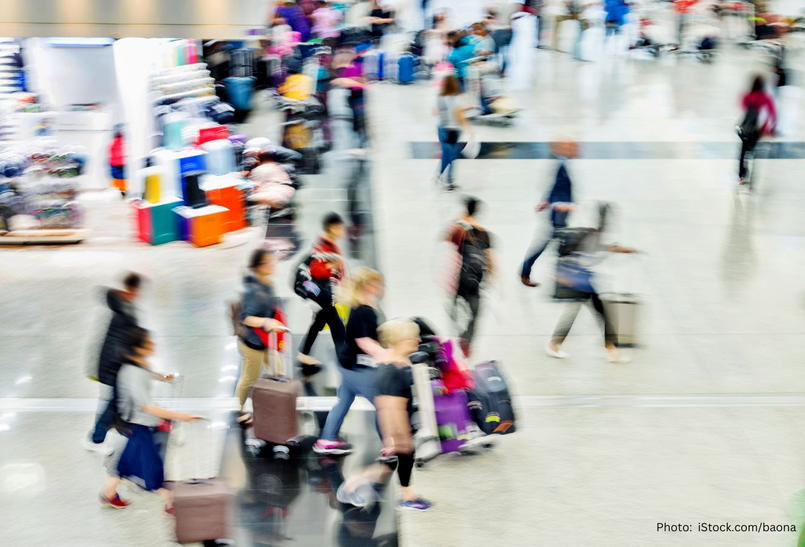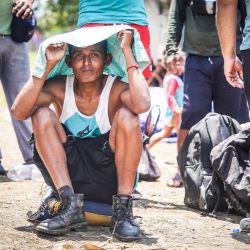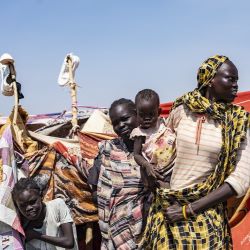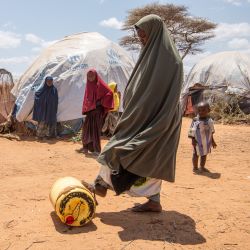Top 10 Migration Issues of 2023

No single defining event shaped migration in 2023 the way that the Russian invasion of Ukraine did in 2022 by dispersing millions of Ukrainians within and beyond the country’s borders, or how 2020 and 2021 were driven by a COVID-19-related shutdown of nearly all global mobility and then a gradual reopening. Instead, 2023 was defined in many ways by the long tails of those earlier shocks, as governments and others grappled with uneven economic recoveries while also facing new labor demands and increasingly protracted displacement crises. Humanitarian migration was on the rise in 2023 and migrants moved in more novel ways by seeking out second and third destinations and following cues from social media. Governments in some countries enacted innovative policies to accommodate growing movement, but political tendencies in many places leaned towards restrictionism. We take stock of these global trends in our annual list of the Top 10 migration issues of the year.
Click below to navigate to each issue:
1. New Models Emerge in Externalization of Humanitarian Protection alongside Migration Management
2. Migrants Seek Out Second and Third Destinations, in a Sign of New Movement Patterns
3. A Transformed Western Hemisphere Reckons with New Migration Reality
4. The Competition for High-Skilled Migrants Is On
5. Years after Fleeing Violence, Many Migrants Are Forced Back
6. A Turn to Temporary Statuses to Provide Protection amid Crises, but Unevenly
7. Despite Rigid External Borders, Movement Within Regions Gets Easier
8. Immigration Fears Stay at Top of Voters’ Minds
9. Amid Disasters and Rising Temperatures, a Potentially Landmark Climate Migration Policy Arrives
10. As a Tool to Support Migration, Social Media and Apps Hit Their Stride
Issue No. 1: New Models Emerge in Externalization of Humanitarian Protection alongside Migration Management
For years, major migrant-destination countries in Europe, North America, and Oceania have sought to push their borders outward, creating restrictions, requirements, and partnerships to prevent spontaneous migration before it reached their borders. This trend persisted in 2023, but a complement also appeared as governments and international organizations found ways to extend outwards the ability to be considered for humanitarian protection and other legal immigration statuses. Rather than simply relying on transit countries to do the heavy lifting on migration management, policies that emerged in 2023 saw would-be destination countries assume a larger responsibility for individuals far from their borders.
The Safe Mobility Office concept launched by the United States, Canada, and Spain offers the clearest example. Safe Mobility Offices (SMOs) in Colombia, Costa Rica, Ecuador, and Guatemala allow individuals to apply for humanitarian protection or labor and other migration pathways to the three countries, ideally reducing the chaotic border arrivals and reliance on smugglers being witnessed today. While only a small percentage of the tens of thousands of applicants at these SMOs have so far received protection, the offices (the first of many expected to be created across Latin America) are nonetheless at the vanguard of a new trend to project screening for protection and other statuses earlier into the migration cycle.
Elsewhere, the rash of novel humanitarian visas and parole programs used in the United States and Europe (described in more detail in Issue No. 6) suggested countries were willing to explore new methods, in quick and adaptive ways, to offer protection to people fleeing myriad crises. Two years after the race to evacuate Afghans fleeing the Taliban takeover and a year after the displacement of millions of Ukrainians, U.S. leaders applied lessons from those experiences to create a new humanitarian parole program for Cubans, Haitians, Nicaraguans, and Venezuelans who have a U.S.-based sponsor, arrive via airplane, and meet other qualifications. Nearly 270,000 individuals had arrived through this pathway as of October.
Still, top migrant-destination countries also expanded enforcement-minded policies to limit access to asylum or stop unauthorized migration before it reached their borders. In creating the humanitarian parole program, the United States also unveiled a post-COVID-19 pandemic strategy that significantly raised the bar to asylum for migrants arriving at the U.S.-Mexico border without a border-post appointment, garnering significant criticism from rights groups.
And while key details remained unclear as of this writing, an in-the-works deal allowing Italy to temporarily house thousands of asylum seekers in Albania could result in the first time a country outside the European Union holds migrants for an EU Member State. Under the terms of the deal, which as of this writing is under a court review in Albania, Italy would retain responsibility for processing individuals’ asylum applications and pay for the construction of the detention centers, which could be operational as soon as early 2024. The Albania-Italy plan bears traces of Australia’s policy of diverting seaborne asylum seekers to detention facilities on the small islands of Nauru and Papua New Guinea, although those individuals were ineligible to be resettled in Australia. The Manus Island center in Papua New Guinea has been closed since 2016, and the Nauru facility was briefly emptied in June 2023 but received new migrants just months later.
EU leaders also solidified the role of North African countries as gatekeepers to the bloc, striking a 1-billion-euro deal with Tunisia to help halt irregular migration despite concerns about discrimination and hostility towards sub-Saharan African migrants there. Morocco also struck bilateral agreements with Germany and Spain.
In the United Kingdom, a controversial proposal to relocate asylum seekers to Rwanda for screening and, if approved, resettlement, was deemed illegal in November by the UK Supreme Court. Earlier in the year, London struck a deal with France to create a new migrant detention center along the English Channel as part of a broader effort to limit the number of small boat arrivals.
These envelope-pushing efforts to restrict irregular movement are part of a long history by Global North countries contending with finite reception capacity, raucous internal politics, and other pressures. As an increasing number of people moved outside of regular channels through the Americas and across the Mediterranean in 2023, these gestures might have been expected. But the countervailing push to also open new pathways, while still fledgling, may mark the start of a new era.
Issue No. 2: Migrants Seek Out Second and Third Destinations, in a Sign of New Movement Patterns
Popular understandings of migration as a simple journey from Point A to Point B further crumbled in 2023, as a new generation of migrants, many having been displaced at an earlier stage, moved from one destination to another. The trend, made possible by the lifting of COVID-19-related barriers to movement and ongoing economic ripple effects from the pandemic, among other causes, highlighted a mismatch between the way that legal systems have long treated migrants and how they actually behave.
Some of the onward movement was unplanned and resulted from incomplete integration in migrants’ initial destinations. For instance, many migrants arriving at the U.S.-Mexico border in 2023 had left their origin country years earlier but struggled to successfully integrate and decided to move onward. Many Haitians, for example, had departed Haiti after a devastating 2010 earthquake but continued to traverse the Americas as local receptiveness soured in Brazil, Chile, and other places amid rising migration and at-times difficult economic conditions. Through the first 10 months of the year, more than 8,500 Brazil- and Chile-born children of Haitian migrants were recorded passing through the Darien Gap between Colombia and Panama.
The largest numbers transiting the Americas, however, were from Venezuela. Many Venezuelans had first sought to settle in nearby countries, where they were often eligible for temporary statuses (see Issue No. 6) but encountered difficulties building a new life. As of November, 70 percent of Venezuelan migrants living in Latin America and the Caribbean struggled to meet basic needs and exercise their rights, according to the UN High Commissioner for Refugees (UNHCR). An increasing number have been setting their sights on reaching the United States and Canada.
In Europe, hundreds of thousands of Ukrainians marked their second year of displacement following Russia’s invasion by leaving Poland and heading deeper into the European Union. While Poland, which borders Ukraine for more than 500 km (300 miles), was initially home to the largest number of displaced Ukrainians, it was overtaken in 2023 by Germany, which hosted 1.2 million Ukrainians as of November (compared to approximately 959,00 in Poland). France, Czechia, and Sweden also saw departures of Ukrainian migrants either heading back to their origin country or elsewhere. Europe’s free-movement area has generally been a benefit for migrants, who are able to pivot to wherever might suit them best. German leaders had also in some cases sought to encourage Ukrainians to settle in Germany.
Other, more ephemeral onward movements also were noteworthy. So-called donkey flights (named for the Punjabi idiom meaning to hop from place to place) involving a mix of air travel to an initial easy-to-access destination followed by irregular onward movement were also a hallmark of 2023. More than 100,000 Cubans, Haitians, and others flew into Nicaragua (which typically does not require a visa) and then continued over land towards the U.S. border. Many of the nearly 53,000 Chinese nationals arriving at the U.S.-Mexico border similarly did so after a stop in Ecuador or another South American country, a journey that has become known as zouxian (“walk the line”). At the other end of the spectrum, El Salvador took steps in 2023 that may dent the surge in arrivals of Africans and Indians using the country as a launch pad to the United States, imposing a $1,130 “airport improvement fee” for arriving nationals from India and 56 African countries.
Migrants’ ability to move between destination countries or take advantage of particular visa regimes has frustrated authorities for years. This is particularly the case in the European Union, which has struggled to enforce the Dublin system requiring asylum seekers’ cases to be resolved in the first Member State in which they enter. In 2023, EU leaders took a step toward resolving these tensions by advancing the New Pact on Migration and Asylum, which policymakers hope to complete before the June 2024 European elections.
Issue No. 3: A Transformed Western Hemisphere Reckons with New Migration Reality
Record numbers of people moved through the Americas in 2023, forcing countries throughout the region—and particularly in Central America—to adapt to new migration realities. Historic barriers segmenting Central America from South America became increasingly porous, as evidenced by the 458,000 migrants passing through the treacherous Darien Gap through October—a more than doubling over the same period in 2022 and 70-fold increase over 2020. The roadless, mountainous jungle region had long buffered Colombia and Panama from each other, but an array of factors—including uneven post-pandemic economic recoveries, mixed immigrant integration records, the professionalization of smuggling services, and the proliferation of social media—have made the region increasingly permeable.
Many migrants were aiming for North America, and the 2.5 million migrant encounters at the U.S.-Mexico border in fiscal year (FY) 2023 were record-setting. Importantly, however, a majority of these migrants were coming from places other than Mexico and northern Central America, representing a dramatic shift in who is moving about the Western Hemisphere. Fifty-one percent of all U.S. border encounters were of nationals from beyond Mexico, El Salvador, Guatemala, and Honduras in FY 2023—up from just 12 percent three years ago. Mexico also recorded a record number of asylum claims (more than 130,000 as of late November), due in part to stricter U.S. border controls.
Caught in the middle was Central America, which has traditionally been a predominantly migrant-origin region but increasingly one of transit—and even destination. Costa Rica, with a population of around 5.3 million, entered the year hosting the world’s third-largest number of asylum applicants, behind only the United States and Germany (Mexico was fifth). With fragile, untested, and overtopped reception systems, many Central American countries sought primarily to speed migrants’ passage through their territories, in the process risking the ire of northern neighbors.
One response was the introduction of Safe Mobility Offices, a U.S.-led effort allowing migrants to be considered for U.S., Canadian, and Spanish migration pathways while in Latin America (see Issue No. 1). International summits in Mexico City and Washington also sought to forge a regionwide consensus on the issue, while new coordination around the Darien Gap represented the strongest effort to date to tackle the humanitarian challenges in that dense jungle. And in the north, Canada opened new pathways for 15,000 Western Hemisphere migrants, primarily from Colombia, Haiti, and Venezuela, as part of an agreement that resulted in the closing of the unofficial Roxham Road border crossing with the United States that drew irregular arrivals from around the world.
Obstacles remained both political and capacity-related in nature, due to the range of ideologies and varying levels of infrastructure maturity throughout the region. And many developments were spearheaded by the United States as part of an effort to limit unauthorized immigration. The approach nonetheless hinted at a sea change in the Western Hemisphere in trends and policymaking.
Issue No. 4: The Competition for High-Skilled Migrants Is On
Rarely is interest in high-skilled immigration as visible as it was in 2023, when post-pandemic labor market restructuring prompted major destination countries worldwide to adopt policies targeting certain highly educated workers. The year began with the highest ever permanent migration to countries of the Organization for Economic Cooperation and Development (OECD), driven in part by international workers filling job postings. And the trend continued through the year, as the World Health Organization (WHO) declared in March that the COVID-19 pandemic was no longer a global health emergency. While concern about rising unauthorized migration hamstrung a more robust immigration overhaul and threatened to undo economically minded reforms in some countries (see Issue No. 8), the desire to woo high-skilled migrants tipped over into open competition in some places.
The most brazen episode was Canada’s new policy taking direct aim at highly skilled foreign-born workers in the United States. Its Tech Talent Strategy opened a pathway for U.S. immigrants holding an H-1B temporary visa, allowing them to apply for a flexible three-year work permit in Canada. While many H-1B workers can get a green card and eventual U.S. citizenship, applicants often face many years of waiting, while prospects for permanent residence in Canada are much quicker. The new Canadian scheme proved popular, and met its target of 10,000 applicants in just one day. Ottawa has tried less-direct moves before; in 2013, the Canadian government rented a billboard in California to display the message: “H-1B problems? Pivot to Canada.”
Washington took notice. In October, the Department of Homeland Security issued long-in-the works changes to streamline the H-1B system and make it more efficient. U.S. officials also raced to address a backlog of hundreds of thousands of applications across visa categories and made tweaks to increase validity periods for work permits and prevent immigrants from temporarily losing their right to work due to administrative backlogs. Partly because of these shifts, immigrants joined the U.S. labor force at a rate more than six times as fast as natives, providing significant relief to the country’s tight labor market.
Similar approaches were evident elsewhere. Reforms to Germany’s Skilled Immigration Act were designed to lure tens of thousands of skilled workers from outside the European Union. New Zealand recorded its highest ever immigration tallies in 2023, as employers were eager to fill empty job postings. Australia announced plans to streamline its immigration processes by creating a pathway to permanent residence for high-skilled immigrants on temporary visas and speeding up processing visas for in-demand professions. And even Japan, which has long struggled with the prospect of increasing immigration, made it easier for multiple types of skilled foreign workers to become long-term residents as it logged a record number of foreign residents (3.2 million).
Still, political pressures limited wider policy changes in places such as the United States, and several countries sought to ensure their reforms were targeted to increase only high-skilled immigration—not immigration writ large. As part of its 2023 changes, for instance, Australia also sought to tighten entry requirements for international students and low-wage workers, as part of a plan to return overall immigration numbers to pre-pandemic levels. The United Kingdom raised the minimum salary required for most immigrants to be eligible for a work visa to 38,700 pounds (U.S. $48,800), up from 26,200 pounds (U.S. $33,100), as well as significantly raising the income threshold for family visas (from 18,600 pounds [U.S. $23,400] to 38,700 pounds [U.S. $48,800]) and scaling back international students’ ability to bring family.
The moves suggest countries are seeking to be more selective in their immigration, prioritizing higher earners and those in in-demand job sectors. Those lucky enough to meet this definition were in hot demand.
Issue No. 5: Years after Fleeing Violence, Many Migrants Are Forced Back
Millions of migrants who had fled Afghanistan, Myanmar, South Sudan, and other crisis-stricken countries in recent years faced the prospect of forced return in 2023, due either to increasing antagonism by host governments or new unrest in their chosen destination. Some migrants in these protracted crises had been displaced for well more than a decade.
Most dramatically, two years after the Taliban’s takeover of Afghanistan—a moment that prompted historic evacuations of Afghan allies by the United States and other Western countries—approximately 1.5 million Afghans without legal status in Pakistan were ordered to leave. The demand followed an increase in violence linked to the Pakistani Taliban, a militant group with ties to the extremist government in Kabul, and prompted hectic scenes as Pakistani authorities went door to door seeking to arrest and deport unregistered Afghan migrants. About 374,000 Afghans had returned by late November, including many registered refugees who feared harassment should they remain in Pakistan.
To the west, leaders in Turkey, Lebanon, and Jordan raised the prospect of deporting many of the millions of Syrian refugees who arrived since Syria’s civil war broke out in 2011, amid a regional softening towards Syrian President Bashar al-Assad. Turkish President Recep Tayyip Erdoğan played on public concerns about the 3.3 million Syrians in his country as part of his re-election bid, and promised to facilitate the voluntary return of 1 million Syrians, in part by building houses in northwest Syria. The process has been slow going, and human-rights groups have reported that several hundred Syrians were forced back into Syria in 2023. Authorities in Lebanon, home to 780,000 Syrians, reportedly deported thousands of Syrians in 2023 as part of a broader crackdown on irregular migration. And many of the 653,000 Syrians in Jordan expressed fears of a similar treatment as Amman began rebuilding its own ties with Assad.
When civil war broke out in Sudan in April, it created a dire humanitarian situation and prompted an exodus of more than 1.3 million people—including more than 336,000 refugees from South Sudan. Atrocities have been described as war crimes, particularly in western Darfur, a region that underwent a genocide two decades ago and which has been stricken by new violence.
And in Bangladesh, where leaders have long struggled with the 968,000 humanitarian migrants from Myanmar—most of them of Rohingya—the government in 2023 embarked on new negotiations aimed at repatriation, although significant returns have yet to transpire.
Collectively, the return migration underscored the fragile nature of humanitarian protection worldwide. The vast majority of forced migrants live in places adjacent to their origin countries—only a tiny share each year are resettled—and events in 2023 demonstrated that many continue to face, years after arrival.
Issue No. 6: A Turn to Temporary Statuses to Provide Protection amid Crises, but Unevenly
This year saw growing use of temporary legal statuses to offer protection and benefits for migrants fleeing crises, disasters, or political unrest. The strategy, used in the European Union, Latin America, and elsewhere, has proven a flexible option to quickly provide safe harbor to millions of people who might otherwise be trapped in lengthy asylum queues or fall through the cracks of legal protection regimes. But it has also raised new challenges as individuals and communities grapple with the fallout from years of lives in limbo.
In the United States, the Biden administration in 2023 offered Temporary Protected Status (TPS), which provides protection from deportation and access to a work permit, to an estimated 472,000 Venezuelans already in the United States. This was one in a string of TPS designations for other nationalities, helping inflate the pool of TPS-eligible individuals to nearly 1.7 million. In late 2022 and early 2023, the administration also created new immigration parole programs permitting entry each month for up to 30,000 Cubans, Haitians, Nicaraguans, and Venezuelans who have a U.S.-based sponsor and can fly to the United States (read more in Issue No. 1). By midyear, nearly 2 million individuals had one of these or other twilight statuses, which grant them some protections but no pathway to a permanent visa.
In some cases, as with the Temporary Protection Directive (TPD) used by the European Union to safeguard millions of displaced Ukrainians, the schemes allow authorities to bypass lengthy and complicated individual status determinations, making it easier to grant protections to large groups all at once. EU leaders in 2023 extended the directive, employed for the first time ever in the wake of Russia’s 2022 invasion of Ukraine, bringing some continuity to more than 4 million migrants’ ability to live, work, attend school, and access health care in countries across the bloc until at least 2025.
Temporary immigration statuses such as TPD and TPS help countries offer immediate protection without forcing migrants through extended backlogs, contending with deadlocked legislatures, or navigating other hurdles. In addition to the humanitarian impulses, allowing migrants to quickly access work and housing legally improves their ability to support themselves and contribute to their host communities.
Yet this policy approach has also created inequities, as protections may hinge on an individual’s nationality, rather than need. There may also be long-term repercussions as sizable numbers of individuals face integration challenges and uncertain futures in their new countries, and as they are left exposed to changing political winds. And the ad hoc offers of status may simply delay difficult processes, as lawyers, caseworkers, and others are forced to navigate a brand-new set of complex rules about who is eligible for which programs.
Perhaps in no place was this clearer than Turkey, which has given temporary protection to millions of Syrians for more than a decade (as a matter of law, Turkey does not grant refugee status to non-Europeans). Only about 201,000 Syrians have become Turkish citizens—a significant number but still a tiny fraction of the total displaced population of 3.2 million as of July—and on the whole migrants from Syria have had few opportunities to transition to long-term or permanent legal status. As economic and other problems have spiraled, these migrants have become easy scapegoats; on his way to re-election this year, Turkish President Recep Tayyip Erdoğan vowed to return 1 million Syrians.
Similarly in Latin America, countries’ offers of status to millions of Venezuelans who have fled since 2016 was historic and offered welcome relief. But years later, millions struggled to find shelter, food, health care, and other basic necessities. These challenges were one reason why growing numbers of Venezuelans have been heading to the United States (see Issue No. 2).
Issue No. 7: Despite Rigid External Borders, Movement within Regions Gets Easier
Although the world is building ever-more-restrictive physical and policy border barriers to prevent irregular migration, movement within certain parts of the world got a bit easier in 2023, as several regions took steps to drop visa requirements or seek closer intraregional integration. As the global economy and labor market emerged from the COVID-19 pandemic, the moves were a tacit acknowledgment of the value of reduced international barriers (see Issue No. 4).
Despite anxiety about general European integration (see Issue No. 8), the visa-free Schengen Zone has been on the march. Croatia became the 27th member of the Schengen Area in January, in the zone’s first expansion since Liechtenstein joined in 2011. Bulgaria and Romania were on the precipice of becoming the 28th and 29th additions as the year came to a close, with the strong support of European Commission President Ursula von der Leyen. While both countries long ago met the technical conditions for membership, their accession has been prevented by concerns from within the bloc about irregular migration.
Rwanda meanwhile abolished visa restrictions for all Africans in November, joining Benin, the Gambia, and the Seychelles in eliminating barriers to intracontinental migration. Kenya is scheduled to drop visa requirements for all arrivals starting in January, which would provide serious momentum given its large economy and status as a regional hub. The moves are part of a slow but steady crawl toward closer integration for the booming continent, which is likely to see its population roughly double by 2050. Most African migrants remain in Africa, and although an African Union passport designed to facilitate free continental movement has been limited to select diplomats and officials, the African Continental Free Trade Area—which Kenyan President William Ruto said was driving the decision to drop visa requirements—could prompt a surge in economic growth.
And the Caribbean Community (CARICOM) of 15 nations declared that Member State residents could soon travel, live, and work visa-free throughout bloc by March 2024, capping a decades-long process of regional integration. The plan excluded Haiti, given the humanitarian and political crises there. But if enacted, regional free movement could significantly tighten ties for countries facing similar economic and climatic pressures.
In isolation, the moves are small steps towards greater regional integration. Promises to drop visa barriers do not necessarily guarantee results, and full regional integration is still a long way off for many parts of the world. But collectively, they represent a global recognition of the value of some level of international migration, especially between similar countries seeking to spur economic growth.
Issue No. 8: Immigration Fears Stay at Top of Voters’ Minds
High levels of irregular migration prompted a backlash in 2023 as countries, particularly in Europe and the Americas, responded by supporting political leaders calling for significant immigration restrictions. The trend was clearest in the European Union, which saw the highest levels of spontaneous migration since the 2015-16 migration and refugee crisis. Some far-right parties in Europe notched historic victories in national elections.
The Netherlands witnessed a shock result in November when the Freedom Party (PVV) of right-wing populist firebrand Geert Wilders won a plurality of seats in parliament. The Rubicon-crossing election may not necessarily lead to Wilders’ ascension to prime minister, but the party’s ability to secure 37 of 150 parliamentary seats was a sign of widespread support for stringent border restrictions, discontent with the European Union, and concerns over religion. The victory was hailed by similar far-right leaders in France, Italy, and elsewhere.
In Germany, the right-wing Alternative for Germany (AfD) party notched remarkable victories in state elections, prompting German Chancellor Olaf Scholz to embrace a harder tone on immigration. The far-right Finns Party earned a spot in Finland’s new government. Voters in Greece endorsed the country’s stiff opposition to irregular migration. Slovakia’s September elections included sizable discussion of unauthorized migration. And a coalition government in Czechia survived a no-confidence vote partly prompted by concerns about rising immigration. In nearby Turkey, meanwhile, President Recep Tayyip Erdoğan doubled down on his promise to return 1 million Syrian refugees living in his country on his way to re-election.
While the United States had another year before its next presidential election, it was clear in 2023 that former President Donald Trump’s restrictive attitudes towards immigration had become doctrine for the Republican Party, as virtually every GOP presidential candidate sought to compete to be the toughest on the border. Republican members of Congress twice moved to impeach Homeland Security Secretary Alejandro Mayorkas over what they describe as a failure to secure the southern border. Towards the end of the year, congressional divides over immigration contributed to bringing the country to the brink of a government shutdown and holding up an emergency spending bill for Israel, Ukraine, and other priorities.
In Latin America, a renewed “pink tide” resulted in a somewhat less welcoming posture, as left-leaning leaders seemed reluctant to turn their backs on communist autocrats by supporting robust integration efforts for migrants. Venezuelan President Nicolás Maduro has succeeded at improving ties with recently elected leaders of Brazil and Colombia. In Argentina, new far-right leader Javier Milei has promised to pull out of the regional Mercosur agreement, which could have wide ramifications for movement around the region.
Immigration was not always a major theme or winning issue in destination-country elections, though. In Poland, voters booted the right-wing Law and Justice Party from power, while Spain’s Vox party did not witness the successes of like-minded politicians elsewhere in the European Union. And despite recording its highest ever immigration figures in 2023, the issue was mostly absent from New Zealand’s October poll. Economic issues such as inflation and housing tended to be higher on many voters’ minds in these places.
In 2024, anxieties about migration are sure to remain at the fore, as voters prepare to head to the polls in the European Union, Mexico, the United States, and elsewhere.
Issue No. 9: Amid Disasters and Rising Temperatures, a Potentially Landmark Climate Migration Policy Arrives
The year 2023 was set to be the hottest ever on record. The impacts of climate change combined with conflict, economic crisis, and other factors to compel and complicate human movement in 2023. Yet the world also saw the unveiling of a potentially landmark policy that, while small, would be the creation of the first-ever legal migration pathway responding to the impacts of climate change.
The new policy would allow 280 people on Tuvalu (total population: 11,200), a Pacific Island nation threatened by the impacts of climate change, to move to Australia, potentially permanently. It was as much a geopolitical move as one grounded in climate policy, given that Australia will also obtain veto power over Tuvalu’s future security pacts. The proposal has also met some opposition in Tuvalu, where many have said they were not consulted on the agreement and have expressed concerns about threats to the country’s sovereignty. But the policy would be tremendously symbolic, given that individuals fleeing the impacts of climate change are not eligible for refugee status or other migration pathways under international treaties or national legislative frameworks.
At the global COP28 climate conference, meanwhile, leaders struck a deal to create a loss and damage fund to help vulnerable countries respond to the impacts of climate change. Key details have yet to be worked out, but the fund could help communities and individuals adapt to environmental pressures rather than move.
All the same, storms, floods, wildfires, and other disasters displaced large numbers of people all over the globe. More than 1 million people were displaced in Somalia, in the face of an historic drought that has exacerbated longstanding conflict and governance failures. Approximately 500,000 more became refugees and asylum seekers in the Sahel, which has confronted similar challenges.
At times, migrants also faced climate disasters while en route. As the planet recorded its single hottest month ever recorded in July, hundreds of thousands of migrants were crossing the desert at the U.S.-Mexico border, in North Africa, and elsewhere. More than 500 people reportedly died while crossing the U.S. southwest border, including 53 migrants who perished while trapped in an unventilated truck in south Texas. Hundreds of migrants were among the thousands of people killed when floodwaters raced through Derma, Libya, an event that was made more likely because of climate change.
As the world hurdles towards a warmer future, events in 2023 suggested the migration- and displacement-related consequences ahead—and also pointed to the potential for new policy responses.
Issue No. 10: As a Tool to Support Migration, Social Media and Apps Hit Their Stride
Migrants have always used word-of-mouth networks, social connections, and news reports to inform their travels. In 2023 it became clear that TikTok, Instagram, and other video-based social platforms have also emerged as crucial tools for international migration, helping individuals travel long distances without personal connections. Smartphone apps also proved critical for entering countries, in order to consolidate paperwork and apply for border appointments.
TikTok, the most downloaded app globally for several years, has made it easier than ever for migrants traveling irregularly to share information about routes and contacts in transit and destination countries. Those traveling far from their homelands—such as individuals from China seeking land routes through the Americas (see Issue No. 3)—can easily find instructions for which routes to take, what gear to bring, and how much to pay a local guide or smuggler. When migrants such as these arrive in the United States, they often do so without a friend, family member, or acquaintance at destination or to guide them along the way, but the ubiquity of cellphones and social media has meant that many can obtain information about shelters, legal aid, and other services.
The services have also made it easier for human smugglers to find clients looking to cross the Darien Gap, the Mediterranean, or other dangerous passages. Under pressure from authorities, Facebook, TikTok, and X (formerly known as Twitter) increased efforts to crack down on posts encouraging illicit crossings of the English Channel and elsewhere in 2023.
Authorities, policymakers, and service workers have also come to rely on smartphone technology to reach migrants, screen them, and speed their processing. For instance, Diia, an app developed by the Ukrainian government before the war began, has allowed migrants to access digital identification documents, pay taxes in Ukraine, and access other government services. And U.S. immigration authorities took a range of steps towards embracing a more digital approach, moving the application processes for several immigration parole pathways online and requiring that asylum seekers arriving at a port of entry at the U.S.-Mexico border first make an appointment using the CBP One app.











